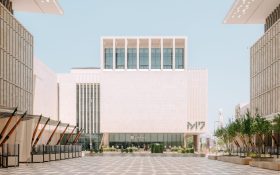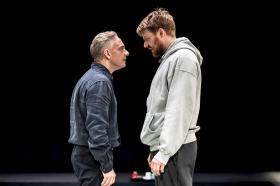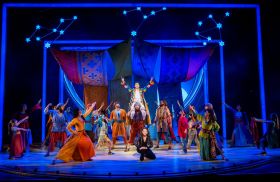Peter Hewitt, chief executive of Arts Council England, recently addressed the Arts Marketing Association annual conference, outlining the challenges and priorities he believes lie ahead for the arts. Central to his argument is that the arts can be transformatory. This is the transcript of his speech.
When I was a young boy, my family lived for a while in Ireland, just south of Dublin. I went to the local primary school. Homework every night included Gaelic but recognising that I was there for just a few months, the teacher – Miss Quigley realised that there was no point in me doing Gaelic. Instead, I had to learn a poem every night, and recite it to the class next morning. Many of the poems were challenging for a nine-year-old and I just learnt them by rote (or on occasions failed to learn them!).
One day, I was given Gerard Manley Hopkins’ Inversnaid to learn. Its first verse begins like this:
This darksome burn, horseback brown,
His rollrock highroad roaring down,
In coop and in comb the fleece of his foam,
Flutes and low to the lake falls home.
And so on.
A simple poem about a mountain stream. Not one of Hopkins’ most sophisticated. But nevertheless one that had a dramatic impact on me, the nine-year-old English boy in Ireland. In reading it, for the first time in my life, I recognised – in the true sense – poetry. Of course, I couldn’t articulate it as such but I heard rhythm, alliteration, word play of a different nature to anything I had read or heard before. It was a magical moment. Looking back, it probably altered the course of the choices I made in my education and, in due course, my career. I leave with you the relevance of this anecdote to what I go on to say today.
And let me first say how pleased I am to have been invited to speak to you today at the Arts Marketing Association conference. This is an important time for Arts Council England and you are an important audience for us.
The AMA is one of the few organisations that crosses all artforms, and bridges the gap between the subsidised and commercial sectors. Importantly, the AMA also reaches across organisations supported by Arts Council England and many other parts of the cultural sector.
I am conscious that many delegates here are from Scotland, Wales and Northern Ireland and that you have your own Arts Councils. The UK Arts Councils talk to each other a lot, and in any case, the arts are genuinely internationalist. The Arts Council in England increasingly so – we’ve just opened a desk of our own in Shanghai. And the UK is, in so many ways, a cultural crossroads. So I hope that much of what I have to say today will have resonance outside England’s borders.
Your work – the work of arts’ marketers – is at the interface between the creation of art and the public’s engagement with art. I don’t need to tell you that if nobody is creating a buzz about the work of artists and arts organisations, then no tickets get sold and no work is seen or heard – and the case for public funding of the arts disappears. The vitality of the arts in this country is dependent on the ability to engage with audiences.
I was asked to speak to you about marketing and audience development in the new Arts Council England. I will turn to that in a moment or two, but my central thesis today will revolve around the following claim and its relevance to making the case for the arts in this country. My claim is quite simply this:
We are dealing in the arts with something powerful, inspirational and capable of effecting deep and positive change in people and in places.
The arts indeed have the power to transform individuals, communities, places.
I want to explore the implications of this claim at greater length in this speech but before doing so, I just want to interject some thoughts on the positive political and media profile enjoyed by the arts in recent months. Because I can’t remember a time, in my career, when the profile of the arts, and interest in the arts, was higher than this recent period.
In those recent months, we have had the discussion generated by Richard Florida’s book The Rise of the Creative Class, in which he posits that artists – along with other innovators, and tolerant and engaging attitudes to difference and diversity – are more important factors in creating economically vibrant cities than money alone. Then we had Charles Clarke and Tessa Jowell on the same public platform powerfully advocating the centrality of arts and creativity in education and society more generally. We had the enormous buzz created around Capital of Culture, and the huge opportunity not just to transform Liverpool but build on the positive platforms in all the other cities, generated by the competition itself. And we even had John Prescott the day after the Capital of Culture announcement spending the first 10 minutes of his keynote speech to the Core Cities advocating a powerful case for culture in regeneration. All of this would not have happened five, 10 years ago, maybe even 12 months ago, and we must take advantage of it as we look forward to 2008 and, if we win the bid, the Olympic Games which, as well as being a sporting jamboree, will of course have a nationwide world class cultural component in the years up to and during 2012.
So why, I ask myself, are the arts achieving such a high profile? Partly, because of the power to contribute positively to a wide range of social agendas. I’ve talked about education and, of course, we have our own ‘Creative Partnerships’ programme. I could talk about Newcastle/Gateshead and especially the Tyneside riverscape as an example of an area revitalised, indeed transformed, through cultural investment. And I could talk about projects in health promotion, crime reduction, community development and other social settings.
But let me say this. The contribution of the arts to such social or economic or regeneration agendas is, in my view, wholly dependent on that same intrinsic power to effect change and to transform people that I referred to earlier. Without one, you don’t get the other. Regardless of where arts are enjoyed, experienced or participated in, if the arts don’t have those qualities, then the experience is diluted, sterile and without impact.
I have no problem with government taking an increasing interest in the arts because of its contribution to meeting broader social, economic and regeneration goals.
Certainly, there can be a downside. With that interest inevitably comes a whole process of performance measures, political scrutiny – and the need to provide evidence about ‘what works’.
Some welcome this as entirely proper in a democratic society. They see accountability as a rightful consequence for a distributor of public money. Indeed, they see dialogue that takes place around mutual aspiration between government and the cultural sector as a force for good in generating greater respect and understanding.
Others see it as bureaucratic and intrusive, as counter to the creative impulse, as likely to distract people and resources away from core purposes, compromising artistic integrity and creating outcomes of lesser quality than would otherwise be the case.
But, whichever position you take, it is factually undeniable that this Government’s record in support of the arts is better than any of its recent predecessors. So there can be, in my view, no justification for alienating government.
We need to find a way of reconciling these potentially contradictory attitudes about the so-called instrumental and intrinsic value.
You may already have seen Ambitions for the Arts, the document we produced last year as the manifesto for the new Arts Council England.
It sets out our priorities, but, I hope goes further than that – to articulate a vision for the arts that can get beyond sterile arguments about excellence versus access, intrinsic versus instrumental. One based on a modern definition of the arts. One that’s open to current trends and emerging arts practice, for example, in arts and technology, cutting across boundaries between artforms and between the arts and other disciplines.
And the starting point is what we call the ‘transformational power of the arts’.
We are passionate about the arts having the power to change lives.
We argue that experiencing the arts can have a lasting and transforming effect on people – that is people as individuals, neighbourhoods, communities, regions and, indeed, entire generations. Good art causes change. And, I believe, it doesn’t matter where it is encountered – classrooms, waiting rooms, galleries, concert halls, opera houses, public houses – it doesn’t matter where it is encountered if it causes change.
I bet everyone in this room can point to those times in our lives when as a result of reading a poem, or experiencing a piece of theatre, or encountering a sculpture, or seeing a film, or hearing a piece of music, something inside you, big or small shifts, and with that shift you are not the same person but have changed. That’s what I’m talking about.
And this, it seems to me, might be our new rallying cry.
Our case is simple. Good art, deep art, troubling art, fun art, dangerous art, exciting art can be transformational, in whatever context it is experienced.
This is how we shall persuade people of the importance of the arts. This is how we can justify our funding. And this is the yardstick by which we should be very content to be measured.
Let me now turn to another aspect of Ambitions for the Arts.
I want to talk about the portfolio of recurrently subsidised arts organisations and our ambition that more of them are ‘thriving’ not just ‘surviving’ in future. Too many people still regard the cultural community as lacking in leadership and managerial acumen. A few high-profile instances of managerial failure, seized upon by the media, can have an extremely damaging effect on opinion.
I strongly believe that, as the sector grows, it needs a new cadre of high quality leaders and managers. This will be partly helped in time by initiatives like the Clore Fellowships.
But even now the cultural sector is populated by many highly skilled, necessarily extremely versatile senior managers and leaders, as well as some superbly run, artistically effective organisations and initiatives which have proved successful in volatile circumstances – and which do not receive the profile they should.
I am interested in what more the cultural sector can do to both tackle its leadership and managerial ‘deficit’ and to tell the stories of leadership and managerial successes more effectively?
At the Arts Council, I have started to talk about the ‘21st century arts organisation’. I would like to draw up a blueprint for the 21st century arts organisation. Not to impose in a ‘one-size-fits-all’ sense. But as a focus for debate with the arts community. And as a model from which certain characteristics could be extracted and applied here or there as appropriate. My 21st century arts organisation is collaborative, resourceful, it understands its public and its audience extremely well, is conscious of changing social and cultural trends, has a board and staff that reflects current day demography, believes in artistic risk, has a forward plan, respects talent, has financial reserves to protect it from the changes that are inevitable in today’s volatile world and, crucially, is customer focused. I invite the arts community to have a debate about this – the 21st century arts organisation – to help define it and then to apply the prototype, selectively, inevitably, to their own reality.
What will marketing look like in the 21st century arts organisation? Good marketers have to be unashamedly outward-looking. For any business, day-to-day operations; motivating staff; assuring quality – these things are crucial for success. For arts organisations this is doubly so. The product depends so completely upon people giving of themselves. Their creativity; their ideas; their commitment to a performance or an audience. So leadership is enormously important in our organisations. And the unique contribution that you bring to that leadership is the perspective of the customer.
It is easy to talk about ‘audiences’ as though they are something abstract. Figures on a balance sheet. A performance indicator. A market segment. An income stream. In your profession, you know that it is important to keep in mind that audiences are made up of people. People with their own individual motivations, values, reasons for coming.
This is important for commercial reasons. The day that any business stops understanding and relating to its customers as individuals, commercial failure will not be far behind. But for arts organisations, there is something else. Our audiences are not simply ‘consumers’. Brands and labels have ‘values’; and supermarkets care about their customers. But these are not the same thing that we offer. Our customers are not passive recipients.
Fundamentally, we are selling a connection. With the performer; with the writer; with the object; with the work. And by engaging, the audience is a participant, too. So it is vitally important to keep in mind the perspective of the customer – because the relationships which our organisations have with customers is a richer one than in any other business I can think of. And the quality of the product depends upon a deep understanding of our audiences.
So what do we know about audiences?
Arts Council England has worked with the sector to understand audiences for many years. For instance, we have financed business planning tools such as BMRB’s Target Group Index (TGI) since 1986. More recently, we have invested 20 million pounds in New Audiences, a programme of action research designed to bring new art to audiences – and new people to the arts. Case studies from the programme have been a feature, I know, of every AMA annual conference since 1999. We have a New Audiences website with details of projects on a searchable database, so that the lessons can be widely shared.
I am delighted that we have just finished surveying Black and Asian people about their experience of the arts. This will enable us to build on the success of Arts Council England’s ‘decibel’ project, which seeks to support black and ethnic minority artists and performers in gaining access to arts venues and getting into the market.
‘decibel’ was launched with a fantastically successful performing arts showcase event in May this year, and I am sure that many of you will have been with us for the event. The report we publish later this year will complement this with a focus on the needs and expectations of Black and Asian people as audiences.
Together with Re:source, the Arts Council published Arts in England in October last year – probably the most complete – and certainly most up to date – audit of people’s engagement with the arts: their attitudes; attendance; and participation.
This report tells us a lot about audiences.
The most striking thing is the sheer scale of participation. Seventy-nine per cent had attended at least one arts event during the previous year – an enormous number. And more frequent visitor numbers are high, too. Those attending in the four weeks before the survey – arguably the core audience for arts venues – are most significant. Some examples: art, photography or sculpture exhibition – 6 per cent; plays or drama – 5 per cent; classical music – 3 per cent.
If you extrapolate these figures, they suggest a regular gallery audience of 2.4 million people, and a theatre audience of around 2 million people. And I stress – these are the ‘regulars’.
There is in fact massive public support for the arts. Seventy-three per cent of the public agree that the arts play a valuable role in the life of the country, and seventy-two per cent say that arts from different cultures contribute a lot to this country. Almost everybody believes it is important that school children should have the opportunity to participate in the arts.
Particularly heartening – from where I sit – is great support for public subsidy. Seventy-four per cent agree that arts and cultural projects should receive public funding.
And I could go on.
But perhaps the most important thing about research like this is what it tells us about the public’s personal commitment and passion for the arts. Three quarters of the public believe the arts play an important part in the life of the country – but interestingly only around a half of that number believe the arts play an important part in their own lives. This is a crucial and fascinating gap.
Reports like Arts in England give a valuable perspective on who is not in the audience: where they are, age profiles, barriers to entry – like health, cost, and transport. And therefore important clues about how to engage with new audiences more effectively.
As any association, the AMA will have a clear focus on professional development for its members, and this is a priority for us too. Arts organisations need highly skilled marketers, so training is very important – and is something we have always taken seriously. For example, through our involvement in the TMA courses – Druidstone, and Walking the Tightrope.
For the 21st century arts organisations we want to see develop, management capability is really important – and nowhere is this more the case than in marketing.
So – for example – this autumn we shall be publishing marketing handbooks on a range of topics: using ambassadors to develop audiences; managing websites; and marketing to disabled audiences.
But practical, tactical skills will never be enough on their own. The 21st century arts organisation we want to see is consciously strategic. I am delighted that we have been able to work with the AMA to commission Stephen Cashman to write Thinking Big, A guide to strategic marketing. And, as it is published today, may I take this opportunity to encourage you all to buy a copy – and to ‘think big’ in your own organisations. Because, as I said earlier, marketers have a key strategic role to play.
And I think here we do need to get seriously strategic, if we are to drive organisations that are genuinely transformational. Because we need a long-term big picture perspective, we need to be very sure what works, and we need to measure the impact we make.
We must research and evaluate our work in sophisticated ways. The transformational power of the arts – as a rallying cry – is not an excuse for woolly thinking about why we programme the work that we do. Research into the characteristics of the truly impactful arts encounters, interventions and experiences is sorely needed.
If we are claiming to change lives, we had better be sure we understand the process by which that happens.
We are pleased to have been able to join forces with our colleagues at Arts Council Wales and the Scottish Arts Council, and – together – to commission Catalyst Arts to look at uses of audience data across three nations. To see what you are currently doing with this information and how better use might be made of it by working together, collaboratively and strategically.
So, to close. My job is to argue the case for the arts across government. But I can only do that based on the quality of the work you do, the clarity of your message, and the impact that you and others deliver.
This time next year the Government will have decided on funding for the arts to 2008. Between now and then, it’s one of my jobs to make the case.
Two questions to leave you with. Firstly, have we or have we not got a new and potent rallying call in ‘the transformational power of the arts’? Secondly, should we make our case alone or should we forge alliances across the cultural sector embracing a broader agenda with colleagues in museums and the wider heritage sector?
Whatever happens and as I began by saying – Arts Council England will continue to play a different role from that of its predecessor body. Yes, we will still work with all our partners to inform and shape a strategy for the arts. Yes, we will still be the vehicle through which much public funding for the arts is delivered.
Yes, we will speak up for and with the sector and make the case for the arts.
And the central case, I believe is the power of the arts to transform lives.
Permission to reproduce this piece was kindly given by Arts Council England.
MORE INFO:
www.artscouncil.org.uk




